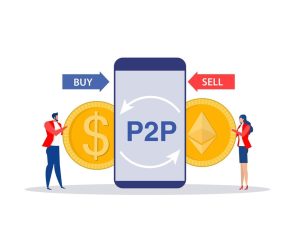
Peer-to-peer (P2P) banking is a financial change that is changing how people and small businesses get loans and how investors look for profits. In this digital age, peer-to-peer loan sites act as go-betweens, putting users in touch with investors straight online.
This piece looks into the workings of peer-to-peer loans, explaining how it works and what its pros and cons might be. Financial technology (FinTech) is changing traditional banking all the time. People who want to broaden their investments and look for new possibilities in the constantly changing world of modern finance need to understand P2P loans.
Understanding Peer-to-peer Lending
A new financial idea called peer-to-peer lending, or P2P lending, has changed how people and businesses get loans and how buyers make money. It uses online sites to connect customers directly with individual investors. The loan process is made easier by these sites, which act as middlemen.
People who want to borrow money post loan ads and buyers can choose to fund them, usually in small amounts. As loan users make payments, investors get both the capital and the interest. This means that investors may get better returns than with a regular savings account.
The Advantages Of Peer-to-peer Lending
There are several benefits to investing in peer-to-peer lending:
- It might give you a better chance of making money than standard savings accounts or stocks.
- It gives buyers the chance to spread their money out over a lot of different loans, which is called diversity.
- Peer-to-peer lending sites have made it easier for people to borrow money, even if they might not be able to get a loan from a bank.
One of the biggest benefits is that buyers can see specific information about loans, which cuts down on the need for middlemen.
Risks And Challenges In P2P Lending
Peer-to-peer loan has some good points, but it also has some bad points. Default risk is a big worry because borrowers might not pay back loans, which would mean owners lose the capital. P2P sites may not be regulated as closely as banks are, which makes theft and other bad behaviour more likely. There are also worries about liquidity since it might be hard to sell P2P loans before their terms end. To lower these risks, you need to do a lot of study, spread your investments out, and be very careful when choosing loans.
How To Get Started With P2P Lending
Opening a Peer to Peer (P2P) loan account is an exciting way to start investing in FinTech. To help you start your journey here are some steps:
- Learn About It: Before you start, take the time to learn about P2P loans. Learn how it works, what the risks are and what the possible benefits are. You can read articles, watch videos and maybe even join online groups or sites where other P2P investors talk about their experiences.
- Assess Your Financial Situation: Think about your financial goals and how much danger you are willing to take. Figure out how much you’re willing to risk on P2P loans. Don’t forget that your trades should fit in with your general plan for your money.
- Choose a Reputable P2P Platform: Do some research and pick a P2P loan tool that you can trust. Look for platforms that have a good history, clear fee systems and clear loan details. Assess the platform image by reading reviews and scores from other users.
- Create an Investor Account: Sign up for the P2P loan site of your choice. Give the needed proof of identity and cash details. Platforms often need proof of who you are and may check your credit.
- Transfer Money: Put the money you want to put into your investment account. Most platforms let you pay your account in a number of ways such as by adding a bank account or credit card.
- Look at Loan ads: Once you’ve added money to your account look at the loan ads that are on the site. These lists give information about borrowers like why they want a loan, their credit score, the amount of the loan and the interest rate. Pick loans that fit your business goal and how much risk you are willing to take.
- Build a Diversified Portfolio: In peer to peer loans diversification is very important. Spread your money out over several loans instead of putting all of your money into one loan to lower your risk. Choose loans with different terms and levels of risk.
- Monitor Your Investments: After you spend, keep an eye on how your loans are going on a daily basis. Look for any late or missed payments or mistakes and be ready to take action if needed. A lot of P2P systems let you keep track of your finances with tools and alerts.
- Reinvest Earnings: As borrowers pay back your loans you’ll get gains on your investments. You could spend these profits on new loans to make your returns even higher and help your P2P lending business grow faster.
- Stay Informed: The world of peer to peer banking is always changing. Always know about new trends, changes in the business and improvements from the tool you’re using. Knowing a lot about something will help you make smart financial choices.
The Future Of P2P Lending
P2P loan seems like it will do well in the future. FinTech innovations are changing the way money is handled as technology keeps getting better. New rules and regulations are likely to make P2P loans safer and more stable for buyers. More major market growth and a wider range of loan choices are expected for the P2P lending environment. Investors who want to make money off of this FinTech shift will need to stay up to date on the business and be able to adapt to changes.
Conclusion
With the rise of FinTech peer to peer banking has become an innovative way to spend. Anyone who wants to be a part of this new financial environment needs to know how peer to peer banking works, what its pros and cons are and how to get started. The future of peer to peer lending is full of exciting opportunities for both investors and users as technology and rules continue to change the business.
 SmartTech blog
SmartTech blog



